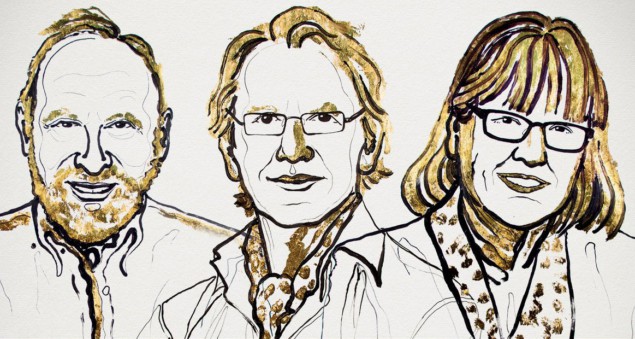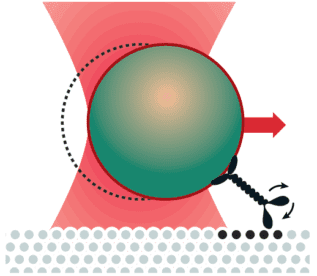
The 2018 Nobel Prize for Physics has been awarded to Arthur Ashkin, Gérard Mourou and Donna Strickland for their “groundbreaking inventions in the field of laser physics”.
The prize is worth SEK 9m (about £870,000) and half goes to Ashkin for his work on “optical tweezers and their application to biological systems”. Mourou and Strickland will claim one quarter of the prize money each “for their method of generating high-intensity ultrashort optical pulses”. The winners will receive their medals at a ceremony in Stockholm on 10 December. Strickland is the first woman to win the prize in 55 years.
Ashkin was born 1922 in New York City, US. He completed a degree in physics from Columbia University in 1947 followed by a PhD from Cornell University in 1952. After his PhD, he moved to Bell Labs in New Jersey where he remained for the rest of his career until he retired in 1992. At 96, he is the oldest person ever to receive the physics Nobel prize.
Mourou was born in Albertville, France, in 1944. He completed a degree in physics from the University of Grenoble in 1967 followed by a PhD in 1973 from Paris VI. After his PhD, Mourou went to the University of Rochester in the US, before heading to the University of Michigan, Ann Arbor, where he became founding director of the Center for Ultrafast Optical Science in 1991. In 2004, Mourou returned to France to become director of the Laboratoire d’ Optique Appliquée at ENSTA-Ecole Polytechnique.
Strickland was born in 1959 in Guelph, Canada. She completed a degree in engineering physics at McMaster University in 1981 followed by a PhD in optics at Rochester in 1989 where Mourou was her doctoral supervisor. Strickland was a research associate at the National Research Council of Canada until 1991 before spending a year at the Lawrence Livermore National Laboratory. In 1992, she moved to Princeton University’s Advanced Technology Center for Photonics and Opto-electronic Materials before joining the physics department of the University of Waterloo in 1997.
Strickland is only the third woman to win the physics prize, the others being Marie Curie in 1903 and Maria Goeppert Mayer in 1963. Speaking shortly after the award was announced, Strickland seemed surprised that she is only the third female physics laureate. “I thought there might have been more,” she said. “Obviously we need to celebrate women physicists because we’re out there. I’m honoured to be one of those women.”
Gradient force
In 1970 Ashkin showed that forces generated by laser beams can trap tiny dielectric particles in air or water. The scattering of light pushes the particles in the direction of beam propagation so two counter-propagating beams will stop a particle from moving along the axis of propagation. Crucially, Ashkin showed that a particle with an index of refraction greater than that of the medium is drawn toward the centre of the beam. This is the result of the intensity gradient that exists between the edge and the centre of the beam. This effect provides the trapping forces in the other two dimensions, creating a 3D optical trap.
A major improvement came in 1986, when Ashkin showed that it is possible to trap particles using just one laser beam – rather than a counter-propagating pair. This involves bringing the beam to an extremely sharp focus that creates a component of the gradient force that opposes the scattering force. This incarnation of the optical trap became known as optical tweezers and could trap particles ranging in size from tens of nanometres to tens of microns.

This size range includes viruses, bacteria and other biological cells and Ashkin immediately realized that optical tweezers could be used to trap and manipulate living organisms. This involved switching from green to infrared light to minimize damage to the subjects.
Optical tweezers have proved invaluable to biophysicists, who have used them to measure the forces involved in biological processes such as the transport of organelles within living cells and how bacteria are propelled by rotating flagella. The latter was done by attaching one end of the molecular motor to a trapped polystyrene ball (see figure). The technique has also been used to study how forces affect large biological molecules such as DNA. This can involve attaching ends of the molecule to two polystyrene balls, which are held in two different optical tweezers – allowing the molecule to be stretched.
Powerful pulses
It was in the mid-1980s at Rochester that Mourou and Strickland devised the technique of chirped-pulse amplification (CPA). Enabling physicists to create petawatt laser pulses that are orders of magnitude more powerful than were achievable without it, CPA now lies at the heart of most high-powered laser facilities in the world.
CPA uses an off-the-shelf table-top laser source to generate pulses that are a femtosecond in length. These pulses only have a small amount of energy – about a nanojoule – which needs to be increased by a factor of about 1012 to get a high-powered petawatt beam. However, as the energy of a short-pulse laser beam is amplified, the refractive index of the medium it is passing through starts to change. Once the power of the beam goes beyond a few gigawatts, nonlinear effects in the medium can lead to so-called self-focusing – damaging the optics in the process. To keep the intensity of laser pulses below the nonlinear threshold, laser systems had to be very large and expensive, and the peak power of laser pulses was still limited to a few terawatts for very large multibeam facilities.

In 1985 Mourou and Strickland, developed CPA to get around the nonlinear effects. It works by taking the short pulse and passing it through a pair of gratings that stretch the pulse in time by a factor of 100,000. The gratings are arranged so that the low-frequency component of the laser pulse travels a shorter path than the high-frequency component does, so the high-frequency component lags behind the low-frequency component and the pulse spreads out in time.
As the pulse is longer, its power is lower and its energy can then easily be increased by passing the pulse through an amplifier such as a titanium– sapphire crystal. The amplified pulse is then passed through a second pair of gratings that reverse the dispersion – forcing the high-frequency component of the laser pulse to travel a shorter path and the low-frequency component to travel a longer path, so the pulse then “recombines” into a short femtosecond pulse at petawatt power levels.
Practical applications of CPA include laser eye surgery and laser micro-machining.



